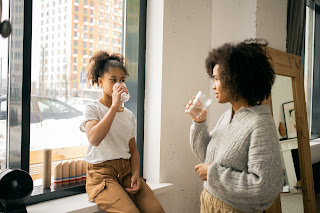Promoting Emotional Wellbeing In Children
I recently read a meme on Facebook, as I’m sure many of us do, that read something like this ‘I act strong for my children but when I’m alone I’m scared and want to cry’. And that got me thinking about how we as parents try to protect our children from any concerns, fears, or uncertainties we may have as parents. After all, as parents we are supposed to have the answers, offer stability, and provide guidance.
But if we look at this action through mindfulness, we see that this very act of love and protection towards our children may in fact be the opposite of what is best for their development.
As mindfulness practitioners we know that feelings come, we
invite them to sit with us, and then after a short time, we let them go. We know
and understand that fear is living in the future and anxiety is the desire to
control a situation. We cannot live in the future, nor may we control every
aspect of a situation. We are not being accepting of what is being offered.
Remember that ‘accepting’ is not ‘giving up’ but more of an acknowledgment of
the circumstances. We may still work towards a more balanced path forward.
The detrimental aspect
of our ‘protective’ actions is that this teaches our children that our emotions
are shameful and need to be hidden, even from those we love. If you recall from
some of my earlier posts and videos, we know that shame is a controlling
behavior and does not promote wellbeing. Try to recall your emotions from a
situation in your life where you felt the need to hide an action due to shame. As
a result, hiding does not teach our children how to handle these new feeling
and emotions that they are experiencing, many for the first time, appropriately.
This may lead to emotional immaturity as they get older.
As a mindfulness instructor I see this result on a steady
basis, adults not knowing how to handle difficult emotions with compassion and
care. As a result, many of these adults have significant negative police
interactions, relationship issues, and some have substance abuse concerns as
well. Mindfulness will help ease their suffering, but it takes love, compassion,
empathy, and time. But it will come.
When we allow our children to see how we handle difficult situations that encompass complex or hard emotions with acceptance and loving kindness, we are truly preparing them for stability, emotional maturity, and wellbeing as they walk their path. Notice I have not said our children need to know explicit details of the situation.
These conversations are something that need to be age
appropriate. But it is certainly fine to say, ‘mommy had a difficult day at work,
and I am mindfully accepting the day’ or ‘daddy and mommy are having a
disagreement and we are mindfully working to find balance and harmony’. No
specific details were offered of the situation, but an acknowledgment of a
difficult situation was given. There was no shame introduced in hiding how you
were feeling.
This is teaching our children how to positively accept
emotions that may at first seem uncomfortable but as time goes on and they get
older they will learn to say, ‘hello fear, I see you. Thank you for visiting
but it is now time to leave’.
Wishing you peace and ease,
Vladimir






.png)
No comments:
Post a Comment